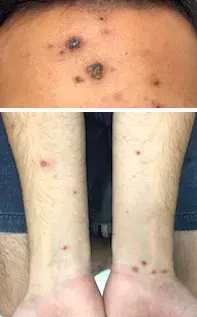What’s the diagnosis?
A teenager with an ear rash and facial weakness



Case presentation
A 16-year-old girl presents with headache and a burning sensation over the right side of her face for the past three days. She also reports feeling ‘a little off-balance’. This morning, her mother noticed a new rash in the girl’s right ear.
On examination, clusters of vesicles on an erythematous base are noted in the conchal bowl of the patient’s ear (Figure 1). She has a slight weakness on the same side of the face and is complaining of increasing pain.
Differential diagnoses
Conditions to consider among the differential diagnoses for a child of this age include the following.
- Herpes simplex virus infection. An infection with herpes simplex virus (HSV) is an important consideration in a patient with acute facial nerve paralysis (Bell’s palsy) and a vesicular rash involving the ear. It is most commonly due to HSV1. Patients present with acute paralysis of one side of the face, with eye and brow drooping and an inability to close the affected eye. A history of cold sores will help to confirm the diagnosis. Patients can be reassured that they will likely fully recover from the paralysis, although cases of permanent facial palsy can occur.
- Herpes zoster. In healthy children, herpes zoster can occur at any time after either primary infection with varicella (chickenpox) or vaccination against varicella, as a result of reactivation of latent varicella zoster virus (VZV) in the sensory ganglia. The incidence increases with age, and the risk is higher in children who were first exposed to varicella in the first year of life or in utero.1 Patients present with erythematous papules that quickly evolve into grouped vesicles or bullae; the rash typically evolves from vesicular to pustular over the first 24 to 48 hours (Figures 2a and b, Figure 3). In individuals who are otherwise healthy, the lesions crust by seven to 10 days and are no longer considered infectious. For the case patient described above, this diagnosis is partially correct but the presence of facial paralysis and isolated auricular involvement of the rash is indicative of a distinct syndrome.
- Ramsay Hunt syndrome. This is the correct diagnosis. Ramsay Hunt syndrome (herpes zoster oticus) is a polycranial neuropathy caused by reactivation of latent VZV. Cranial nerves V, IX and X can be affected. This is a clinical diagnosis, based on the triad of ear pain, zoster of the auditory canal and auricle, and ipsilateral facial paralysis. Vestibular disturbances frequently occur. Taste perception, hearing and lacrimation may also be affected.
Diagnosis
Ramsay Hunt syndrome is a clinical diagnosis based on the dermatomal distribution of erythematous vesicles in the ear or mouth and associated peripheral facial palsy. A polymerase chain reaction (PCR) test for VZV DNA is available and viral culture from a swab of lesional skin may be performed, but the diagnosis should be made on clinical grounds.
Management
The mainstay of treatment for Ramsay Hunt syndrome is antiviral treatment and a short course of corticosteroids, along with specific analgesia for neuropathic pain. Antiviral therapy for this and all forms of zoster is most effective if commenced within 72 hours after the appearance of the rash. The doses of antiviral agents used are:
- aciclovir 20 mg/kg (up to 800 mg) orally, five times daily for seven days
- valaciclovir 1 g orally, eight-hourly for seven days
- famciclovir 250 mg orally, eight-hourly for seven days.
Corticosteroids are important in the treatment of Ramsay Hunt syndrome. The neural oedema in the narrow space of the internal auditory canal causes neural compression and hypoxia, worsening the neural degeneration. A course of prednisone, 1 mg/kg daily for five days, is appropriate.
Pain relief is an important consideration because postherpetic neuralgia can be very disruptive, although it is less severe in children. Simple analgesia, including paracetamol, should be commenced in the first instance. Tricyclic antidepressants (amitriptyline, imipramine, nortriptyline) may also be used to treat neuropathic pain, starting at a low dose and increasing gradually. Patients should be counselled that a pain relief benefit may not be seen for three or more weeks. In this case, simple analgesia was ineffective but the patient rapidly improved when treated with amitriptyline, 20 mg daily, which was required for only one week.
There is a live attenuated zoster vaccine for the prevention of reactivation disease. Herpes zoster vaccination can decrease the risk of developing shingles and postherpetic neuralgia among individuals aged 50 years and over, but it is not indicated for the treatment of herpes zoster or postherpetic neuralgia. The case patient described above was vaccinated at 18 months of age with measles–mumps–rubella–varicella vaccine. Immunisation does not always prevent zoster, but if zoster does occur then it is less common and less severe than after wild virus infection.
It is important to educate patients that although shingles or Ramsay Hunt syndrome is not normally contagious, it may be passed on to individuals who are not immune to varicella. This includes children who have not been previously infected or vaccinated against the disease, and those who are immunocompromised may acquire varicella as a result of contact with a patient who has zoster.
Reference
1. Feder HM Jr, Hoss DM. Herpes zoster in otherwise healthy children. Pediatr Infect Dis J 2004; 23: 451-457.
Updated: 4/5/2017
Ear disorders

